
Інструкція із застосування ГЛІАДЕЛЬ 7,7 мг ІМПЛАНТ
Введення
Опис: інформація для користувача
GLIADEL 7,7 мг імплантат
Кармустин
Перед тим, як почати використовувати препарат, уважно прочитайте весь опис, оскільки він містить важливу інформацію для вас.
- Збережіть цей опис, оскільки вам може знадобитися знову його прочитати.
- Якщо у вас виникли питання, проконсультуйтеся з вашим лікарем.
- Якщо ви відчуваєте побічні ефекти, проконсультуйтеся з вашим лікарем, навіть якщо вони не перелічені в цьому описі. Див. розділ 4.
Зміст опису:
- Що таке GLIADEL імплантат і для чого він використовується
- Що потрібно знати перед тим, як почати використовувати GLIADEL імплантат
- Як використовувати GLIADEL імплантат
- Можливі побічні ефекти
- Збереження GLIADEL імплантату
- Зміст упаковки та додаткова інформація
1. Що таке Gliadel імплантат і для чого він використовується
GLIADEL імплантат - це система вивільнення активної речовини кармустину безпосередньо в місце, де раніше розташовувався пухлина мозку, після її видалення під час операції. Кармустин належить до групи протипухлинних речовин, які дозволяють боротися з ростом пухлинних клітин у мозку.
GLIADEL імплантат можна використовувати в поєднанні з радіотерапією для лікування пухлин мозку.
Було доведено, що GLIADEL імплантат подовжує тривалість життя пацієнтів з пухлиною мозку.
2. Що потрібно знати перед тим, як почати використовувати Gliadel імплантат
Не використовувати GLIADEL імплантат
- якщо ви алергічні на активну речовину або на будь-який інший компонент цього препарату (перелічені в розділі 6).
Попередження та обережність
Після операції з видалення пухлини мозку та введення GLIADEL імплантату ваш лікар або хірург буде спостерігати за вами, щоб уникнути ускладнень. У деяких випадках лікар може знову операцію (через ускладнення або рецидив пухлини). Ускладнення включають:
- Конвульсії (припадки)
- Інфекції мозку (інфекції всередині черепа)
- Запалення мозку через накопичення рідини
- Втрата спинномозкової рідини
- Проблеми з загоєнням рани
Ваш лікар буде спостерігати за вами уважно, якщо ви приймаєте стероїди через запалення або підвищений тиск рідини в мозку.
Перед введенням імплантатів лікар може потрібно закрити канал у мозку, щоб уникнути проходження імплантатів через нього, що могло б спричинити накопичення рідини всередині черепа.
Після введення GLIADEL імплантату за допомогою методів візуалізації можна виявити запалення мозку через накопичення рідини та запалення, викликане GLIADEL імплантатом або прогресію пухлини.
Інші препарати та GLIADEL імплантат
Повідомте вашого лікаря, якщо ви приймаєте або нещодавно приймали інші препарати, навіть ті, які можна придбати без рецепта.
Вагітність та лактація
Якщо ви вагітні або перебуваєте в період лактації, вважаєте, що можете бути вагітною або плануєте завагітніти, проконсультуйтеся з вашим лікарем перед тим, як використовувати цей препарат. GLIADEL імплантат не вивчався у вагітних жінок. Було доведено, що активна речовина кармустин негативно впливає на розвиток плода. GLIADEL імплантат не повинен використовуватися у вагітних жінок або під час лактації. Жінкам репродуктивного віку рекомендується використовувати ефективні методи контрацепції протягом 6 місяців після отримання GLIADEL імплантату. Чоловікам, чиї партнерки перебувають у репродуктивному віці, рекомендується використовувати методи контрацепції протягом 90 днів після отримання GLIADEL імплантату.
Водіння транспортних засобів та використання машин
Не рекомендується водіння після лікування. Проконсультуйтеся з вашим лікарем перед тим, як водити транспортні засоби або використовувати машини.
3. Як використовувати Gliadel імплантат
GLIADEL імплантат повинен використовуватися лише у дорослих.
Хірург або фармацевт будуть забезпечувати наявність препарату для вашої операції. Після видалення пухлини мозку хірург введе до восьми імплантатів у простір, який займала пухлина. Ваш хірург вирішить, скільки імплантатів введе у порожнину, створену після видалення пухлини мозку. Імплантати розміщуються так, щоб покрити максимально можливу поверхню цієї порожнини. Після операції імплантати розчиняються повільно протягом двох-трьох тижнів, вивільняючи кармустин безпосередньо до клітин, що оточують.
Якщо у вас виникли питання щодо використання цього продукту, проконсультуйтеся з вашим хірургом.
4. Можливі побічні ефекти
Як і всі препарати, GLIADEL може викликати побічні ефекти, хоча не всі люди їх відчувають.
Якщо ви вважаєте, що будь-який з побічних ефектів, які ви відчуваєте, є серйозним або якщо ви помітили будь-який побічний ефект, який не перелічений в цьому описі, повідомте вашому лікарю.
Нижче перелічені побічні ефекти, які найчастіше спостерігалися під час клінічних досліджень у пацієнтів з злоякісними гліомами (пухлинами мозку) нового діагнозу (120 пацієнтів) або злоякісними гліомами рецидиву діагнозу (110 пацієнтів).
Наступні чотири категорії побічних ефектів можуть бути пов'язані з використанням GLIADEL імплантату:
|
Під час клінічних досліджень спостерігалися наступні побічні ефекти у пацієнтів, які були подібні до тих, які спостерігалися у пацієнтів, які піддавалися операції з видалення пухлини мозку без введення GLIADEL імплантатів.
Дуже часті: можуть впливати на більше 1 з 10 пацієнтів
- Психічні розлади
Депресія
- Розлади нервової системи
Слабкість, особливо з одного боку тіла; припадки (спазми); сплутаність; головний біль, запалення черепа; сонливість; порушення мови
- Судинні розлади
Запалення судин
- Гастроінтестинальні розлади
Нудота; блювота; запор
- Розлади шкіри та підшкірної клітковини
Висипка; випадання волосся
- Ниркові та сечові розлади
Інфекція сечовивідних шляхів
- Загальні розлади та порушення в місці введення
Погіршення загального стану; інфекція; головний біль; відчуття слабкості; гарячка або біль, порушення загоєння рани.
Часті: можуть впливати до 1 з 10 пацієнтів
- Розлади крові та лімфатичної системи
Зниження кількості червоних кров'яних тілечок (анемія), що може спричинити блідість шкіри, втому та задишку; зниження кількості тромбоцитів, що збільшує ризик кровотечі; збільшення кількості білих кров'яних тілечок
- Ендокринні розлади (гормональні порушення)
Цукровий діабет
- Розлади метаболізму та харчування
Периферичний набряк (надмірна кількість рідини в руках або ногах); низький рівень натрію в крові, що може спричинити втому та сплутаність, м'язові тиків, спазми та кома; високий рівень цукру в крові, низький рівень калію в крові, що може спричинити слабкість та м'язові тиків, а також порушення серцевого ритму
- Психічні розлади
Зміни особистості, надмірна тривога, порушення мислення, галюцинації, безсоння (недостатня кількість сну)
- Розлади нервової системи
Амнезія (втрата пам'яті); збільшення внутрішньочерепного тиску через надмірну кількість рідини; параліч обличчя; порушення координації; зниження чутливості до стимуляції; порушення відчуттів, такі як печія та поколювання; порушення ходьби; головокружіння; епілептичні припадки (спазми); тремор; менінгіт; абсцес (локалізовані нагромадження гною); втрата свідомості
- Очні розлади
Затьмарене або аномальне зір, запалення очей; біль в очах
- Судинні розлади
Кровотеча; високий або низький тиск
- Дихальні, грудні та медіастинальні розлади
Пневмонія або інфекція легенів, що спричиняє задишку, кашель та гарячку
- Гастроінтестинальні розлади
Інфекція ротової порожнини; діарея; запор; недержання калу (неконтрольоване виділення калу); порушення ковтання; кровотеча в шлунку або кишечнику
- Розлади епітелію та підшкірної клітковини
Висипка
- М'язові та скелетні розлади
Інфекція
- Ниркові та сечові розлади
Недержання сечі, інфекції сечовивідних шляхів
- Загальні розлади та порушення в місці введення
Біль в животі, від спини до грудей; запалення обличчя; абсцес (локалізовані нагромадження гною); випадкова травма; алергічна реакція; біль в шиї; сепсис
Побічні ефекти, які спостерігаються рідше (у 1-10 пацієнтів з 1000)
Травматичні ушкодження, інтоксикації та ускладнення терапевтичних процедур
Пневмоцефалія (накопичення повітря в місці імплантату)
Звіт про побічні ефекти
Якщо ви відчуваєте будь-який побічний ефект, повідомте вашому лікарю, навіть якщо це можливі побічні ефекти, які не перелічені в цьому описі.
Ви також можете повідомити про них безпосередньо через Систему моніторингу безпеки лікарських засобів для людини: www.notificaram.es. Надсилаючи повідомлення про побічні ефекти, ви можете допомогти надати більше інформації про безпеку цього препарату.
5. Збереження Gliadel імплантату
Тримайте цей препарат поза досяжністю дітей.
Зберігайте в морозильній камері при температурі -20°C або нижчій.
Невідкриті зовнішні пакети можна зберігати при температурі нижчій за 22°C протягом максимум 6 годин. Пакети можна повторно заморозити один раз, якщо вони не були відкриті та перебували при температурі нижчій за 22°C протягом максимум 6 годин. Після повторної заморозки препарат повинен бути використаний протягом 30 днів.
Не використовувати GLIADEL імплантат після закінчення терміну придатності, вказаного на упаковці та/або на пакеті після зазначення "Термін придатності". Термін придатності - останній день місяця, який вказано. Ваш хірург або фармацевт лікарні перевірять термін придатності перед використанням імплантатів.
6. Зміст упаковки та додаткова інформація
Склад ГЛЯДЕЛ імплант
- Активний інгредієнт - кармустин. Кожен імплант містить 7,7 мг кармустину
- Інший компонент - полифепросан 20
Вигляд продукту та вміст упаковки
ГЛЯДЕЛ імплант доступний у коробках по вісім круглих імплантованих пластин. Ці пластини є імплантами у формі диска білого опалесцентного до жовтого кольору. Кожен імплант упакований окремо у конверт, покритий алюмінієвою фольгою.
Уповноважений на отримання дозволу на продаж та відповідальний за виробництво
Уповноважений на отримання дозволу на продаж
CLINIGEN HEALTHCARE B.V.
Schiphol Boulevard 359
WTC Schiphol Airport, D Tower 11th floor
1118BJ Schiphol
Нідерланди
Відповідальний за виробництво
ALMAC PHARMA SERVICES (IRELAND) LIMITED
Finnabair Industrial Estate
Dundalk
Co. Louth A91 P9KD
Ірландія
Тел: +353 42 932 0718
Факс: +353 42 932 0718
ALMAC PHARMA SERVICES LIMITED
20 Seagoe Industrial Estate
Craigavon, BT63 5QD,
Сполучене Королівство
Тел: +44 (0)28 3836 3363
Факс: +44 (0)28 3836 3300
Дата останнього перегляду цього проспекту: 04/2021
Детальна та актуальна інформація про цей лікарський засіб доступна на сайті Агенції лікарських засобів та медичних виробів Іспанії (AEMPS) http://www.aemps.gob.es/
ІНФОРМАТИВНИЙ ПРОСПЕКТ ДЛЯ МЕДИЧНИХ СПЕЦІАЛІСТІВ
- НАЗВА ЛІКАРСЬКОГО ЗАСОБУ
ГЛЯДЕЛ 7,7 мг імплант
- ЯКІСНА ТА КІЛЬКІСНА КОМПОЗИЦІЯ
Кожен імплант містить 7,7 мг кармустину.
Для ознайомлення з повним переліком допоміжних речовин див. розділ 6.1.
- ФАРМАЦЕВТИЧНА ФОРМА
Імплант.
Імплант у формі диска білого опалесцентного до жовтого кольору.
- КЛІНІЧНІ ДАНІ
4.1Терапевтичні покази
ГЛЯДЕЛ імплант показаний для лікування дорослих пацієнтів з високим ступенем злоякісного гліому як ад'ювантна терапія після хірургічного втручання та радіації.
ГЛЯДЕЛ імплант показаний як ад'ювантна терапія після хірургічного втручання для лікування пацієнтів з рецидивним гліобластомом, діагностованим гістологічно, у яких показане хірургічне втручання.
4.2Дозування та спосіб застосування
Дозування
Внутрішньолезіонне застосування тільки.
Кожен імплант ГЛЯДЕЛ містить 7,7 мг кармустину, тому після розміщення восьми імплантів у порожнину після видалення пухлини, виділяється доза 61,6 мг.
Педіатричне населення
Безпека та ефективність ГЛЯДЕЛ імплант у дітей молодших 18 років не встановлені. Даних немає.
Способ застосування
Рекомендується розміщення максимум восьми імплантів, якщо розмір і форма порожнини після видалення пухлини дозволяють. Можуть використовуватися імплантати, розрізані навпіл, але імплантати, розділені на більше двох частин, повинні бути видалені у контейнери для біологічних відходів (див. розділ 6.6).
Рекомендується розміщувати імплантати безпосередньо з внутрішньої стерильної упаковки продукту у порожнину після видалення пухлини. Можуть застосовуватися аплікації оксикелюлози над імплантатами для їх закріплення на поверхні порожнини (див. розділ 6.6).
4.3Протипоказання
Гіперчутливість до активного інгредієнту або до одного з допоміжних речовин, перелічених у розділі 6.1.
4.4Спецальні попередження та обережність при застосуванні
Пацієнти, які піддаються краніотомії та імплантації ГЛЯДЕЛ імплант, повинні бути під суворим спостереженням для виявлення можливих ускладнень краніотомії, які включають судоми, інфекції внутрішньочерепні, аномальну цілісність, набряк мозку та пневмоцефалію (див. розділ 4.8). У пацієнтів, які отримують ГЛЯДЕЛ імплант, описані випадки внутрішньочерепного масового ефекту, який не реагує на кортикостероїди, включаючи один випадок, який призвів до церебральної гернії. У пацієнтів, які отримують ГЛЯДЕЛ імплант, необхідно суворо спостерігати за появою набряку мозку/гіпертензії після застосування кортикостероїдів (див. розділ 4.8). Втрати ліквору були частішими у пацієнтів, які отримують ГЛЯДЕЛ імплант. Рекомендується особливий догляд для герметичного закриття твердої мозкової оболони та лікування місцевих ран (див. розділ 4.8).
Описані зміни у стінці мозкових кровоносних судин, розташовані поблизу пластини ГЛЯДЕЛ, включаючи випадки аневризми, які спричиняють церебральне кровотечу через кілька місяців після імплантації пластини ГЛЯДЕЛ. Необхідно уникати імплантації пластин ГЛЯДЕЛ поруч з великими мозковими судинами.
Розвиток набряку мозку з масовим ефектом (через рецидив пухлини, інфекцію внутрішньочерепну або некроз) може потребувати повторного хірургічного втручання та, в деяких випадках, видалення ГЛЯДЕЛ імплант або його решток.
Необхідно уникати спілкування між порожниною після хірургічного втручання та системою шлуночків, щоб уникнути переміщення імплантатів у систему шлуночків та можливого розвитку гідроцефалії. Якщо існує шлях спілкування більший за діаметр імплантату, його необхідно закрити до імплантації ГЛЯДЕЛ імплант.
Комп'ютерна томографія та магнітно-резонансна томографія можуть показувати інтенсифікацію щільності мозкової тканини навколо порожнини після видалення пухлини після розміщення імплантатів ГЛЯДЕЛ. Це збільшення інтенсивності може відображати набряк чи запалення, спричинені імплантатами ГЛЯДЕЛ, або прогресію пухлини.
Жінки репродуктивного віку повинні використовувати ефективні методи контрацепції протягом至少 6 місяців після отримання ГЛЯДЕЛ імплант.
Чоловікам з партнерками репродуктивного віку необхідно радити використовувати ефективні методи контрацепції протягом至少 90 днів після отримання ГЛЯДЕЛ імплант
4.5Взаємодія з іншими лікарськими засобами та іншими формами взаємодії
Взаємодії ГЛЯДЕЛ імплант з іншими лікарськими засобами чи хіміотерапією не були формально вивчені.
4.6Фертильність, вагітність та лактація
Вагітність:
Не існує досліджень ГЛЯДЕЛ імплант у вагітних жінок, ні досліджень, які оцінюють токсичність ГЛЯДЕЛ імплант на репродукцію.
Коли застосовується системно, кармустин, активний інгредієнт ГЛЯДЕЛ імплант, може мати генотоксичні ефекти та негативно впливати на розвиток плода (див. розділ 5.3). Тому не рекомендується використовувати ГЛЯДЕЛ імплант під час вагітності, ні у жінок репродуктивного віку, які не використовують методи контрацепції. Жінки репродуктивного віку повинні використовувати ефективні методи контрацепції протягом至少 6 місяців після отримання ГЛЯДЕЛ імплант.
Чоловікам з партнерками репродуктивного віку необхідно радити використовувати ефективні методи контрацепції протягом至少 90 днів після отримання ГЛЯДЕЛ імплант. Однак, якщо все ж таки вважається необхідним використання ГЛЯДЕЛ імплант під час вагітності, пацієнтці необхідно повідомити про потенційні ризики для плода. У разі якщо пацієнтка залишається вагітною після отримання ГЛЯДЕЛ імплант, необхідно шукати генетичну консультацію.
Лактація:
Не відомо, чи виділяються компоненти ГЛЯДЕЛ імплант у материнське молоко. Через можливий ризик серйозних побічних реакцій кармустину у дітей, лактація протипоказана.
Фертильність:
Не проводилися дослідження фертильності з ГЛЯДЕЛ імплант.
4.7Ефекти на здатність керувати транспортними засобами та використовувати машини
ГЛЯДЕЛ імплант не впливає на здатність керувати транспортними засобами та використовувати машини. Однак, краніотомія та ГЛЯДЕЛ імплант можуть спричиняти порушення зору та нервової системи. Тому пацієнт повинен знати про потенційний ефект цих реакцій на здатність керувати транспортними засобами чи використовувати машини.
4.8Побічні реакції
Спектр побічних реакцій, спостережених у пацієнтів з високим ступенем злоякісного гліому нового діагнозу та рецидивним гліомою, був узгоджений з тим, який спостерігається у пацієнтів, які піддаються краніотомії за гліомою.
Нижче перелічені побічні реакції, які спостерігалися у пацієнтів, які отримують ГЛЯДЕЛ імплант під час клінічних досліджень.
Побічні реакції перелічені у порядку зменшення тяжкості всередині кожної частоти.
Перша хірургічна операція
Наступні дані відповідають побічним реакціям, які спостерігалися у 5% або більше з 120 пацієнтів з високим ступенем злоякісного гліому нового діагнозу, які отримували ГЛЯДЕЛ імплант у клінічному дослідженні.
Побічні реакції, які спостерігалися у ≥ 5% пацієнтів, які отримували ГЛЯДЕЛ імплант під час першої хірургічної операції
Класифікація за органами та системами | Побічні реакції | |
Розлади ендокринної системи | часті | Цукровий діабет |
Розлади психіки | дуже часті | Депресія |
часті | Розлад особистості, тривога, порушення мислення, галюцинації, безсоння | |
Розлади нервової системи | дуже часті | Геміплегія, судоми, сплутаність, набряк мозку, афазія, сонливість, порушення мови |
часті | Амнезія, підвищення внутрішньочерепного тиску, розлади особистості, тривога, параліч обличчя, нейропатія, атаксія, гіпостезія, парестезія, порушення мислення, порушення ходьби, головокружіння, судоми типу "гранд мал", галюцинації, безсоння, тремор | |
Очні розлади | часті | Набряк кон'юнктиви, порушення зору, порушення поля зору |
Судинні розлади | дуже часті | Тромбофлебіт |
часті | Кровотеча | |
Дихальні, грудні та медіастинальні розлади | часті | Легенева емболія |
Інфекції та інвазії Розлади травної системи | часті | Пневмонія |
дуже часті | Нудота, блювота, запор | |
Розлади шкіри та підшкірної клітковини | часті | Діарея |
Розлади шкіри та підшкірної клітковини | дуже часті | Висип, алопеція |
Ниркові та сечові розлади | часті | Інфекція сечових шляхів, недержання сечі |
Загальні розлади та порушення в місці застосування | дуже часті | Погіршення, головний біль, астенія, інфекція, гарячка, біль, порушення цілісності |
часті | Біль у животі, біль у спині, набряк обличчя, біль у грудній клітці, абсцес, випадкова травма, набряк кінцівок |
Гіпертензія внутрішньочерепного тиску була зареєстрована частіше у пацієнтів, які отримували ГЛЯДЕЛ імплант, ніж у тих, хто отримував плацебо (9,2% проти 1,7%), і була пізньою знахідкою, збігаючись з рецидивом пухлини, і вважалася малоймовірною асоціацією з використанням ГЛЯДЕЛ імплант (див. розділ 4.4).
Втрати ліквору були частішими у пацієнтів, які отримували ГЛЯДЕЛ імплант, ніж у пацієнтів, які отримували плацебо. Однак не збільшувалися інфекції внутрішньочерепні чи інші порушення цілісності (див. розділ 4.4).
Хірургічна операція при рецидиві захворювання
Було спостережено наступні побічні реакції після операції у 4% або більше пацієнтів, які отримували ГЛЯДЕЛ імплант під час повторної хірургічної операції. Перелічені тільки ті побічні реакції, які були частішими у групі, яка отримувала ГЛЯДЕЛ імплант, ніж у групі плацебо, за винятком ефектів на нервову систему, яких імплантати плацебо могли бути причиною. Ці побічні реакції або не були присутні до операції, або погіршилися після операції протягом періоду спостереження. Період спостереження тривав до 71 місяця.
Побічні реакції, які спостерігалися у ≥ 4% пацієнтів, які отримували ГЛЯДЕЛ імплант під час повторної хірургічної операції
Класифікація за органами та системами | Побічні реакції | |
Розлади крові та кровотворної системи | часті | Анемія |
Розлади метаболізму та харчування | часті | Гіпонатрімія |
Розлади нервової системи | дуже часті | Судома, геміплегія, головний біль, сонливість, сплутаність |
часті | Афазія, ступор, набряк мозку, підвищення внутрішньочерепного тиску, менінгіт чи абсцес | |
Судинні розлади | часті | Тромбофлебіт |
Дихальні, грудні та медіастинальні розлади | часті | Легенева емболія |
Розлади травної системи | часті | Нудота, блювота |
Розлади шкіри та підшкірної клітковини | часті | Висип |
Ниркові та сечові розлади | дуже часті | Інфекція сечових шляхів |
Загальні розлади та порушення в місці застосування | дуже часті | Порушення цілісності |
часті | Інфекція, біль |
Наступні побічні ефекти, які не включені до таблиці нижче, були зареєстровані у пацієнтів, які отримували імплант ГЛЯДЕЛ у всіх дослідженнях. Перелічені тільки ті побічні ефекти, які не були присутні під час періоду до операції, або погіршилися після операції протягом періоду спостереження. Не було можливості встановити, чи був імплант ГЛЯДЕЛ причиною цих ефектів
Побічні ефекти у пацієнтів, які отримують імплант ГЛЯДЕЛ
Класифікація за органами та системами | Побічні реакції | |
Розлади крові та кровотворної системи | часті | Тромбоцитопенія, лейкоцитоз |
Розлади метаболізму та харчування | часті | Гіпонатрімія, гіперглікемія, гіпокаліємія |
Розлади нервової системи | часті | Гідроцефалія, атаксія, головокружіння, геміплегія, кома, амнезія, диплопія |
рідкі | Кровотеча в мозок, інфаркт мозку | |
Розлади психіки | часті | Депресія, порушення мислення, безсоння, параноїдна реакція |
Очні розлади | часті | Порушення зору, біль в очах |
Серцево-судинні розлади | часті | Гіпертонія, гіпотонія |
Дихальні, грудні та медіастинальні розлади | часті | Інфекція, пневмонія аспіраційна |
Розлади травної системи | часті | Діарея, запор, дисфагія, геморрагія травної системи, недержання калу |
Розлади шкіри та підшкірної клітковини | часті | Висип |
М'язово-скелетні та сполучні тканини розлади | часті | Інфекція |
Ниркові та сечові розлади | часті | Недержання сечі |
Загальні розлади та порушення в місці застосування | часті | Набряк кінцівок, біль у шиї, випадкова травма, біль у спині, алергічна реакція, астенія, біль у грудній клітці, сепсис |
Травми, отруєння та ускладнення терапевтичних процедур | рідкі | Пневмоцефалія |
Було зареєстровано випадки накопичення повітря у зоні імплантату з ГЛЯДЕЛ, іноді асоційовані з неврологічними симптомами (геміплегія, афазія, судоми).
Наступні чотири категорії побічних реакцій можуть бути пов'язані з лікуванням ГЛЯДЕЛ імплант.
Судоми:
У клінічному дослідженні першої хірургічної операції частота судом у перші п'ять днів після імплантації становила 2,5% у групі ГЛЯДЕЛ імплант.
У клінічному дослідженні хірургічної операції при рецидиві захворювання частота судом після операції становила 19% у пацієнтів, які отримували ГЛЯДЕЛ імплант. У цьому дослідженні 12/22 (54%) пацієнтів, які отримували ГЛЯДЕЛ імплант, мали початок судом або погіршення існуючих протягом перших п'яти днів після операції. Медіана часу до початку судом або погіршення існуючих після операції становила 3,5 доби у пацієнтів, які отримували ГЛЯДЕЛ імплант.
Набряк мозку:
Розвиток набряку мозку з масовим ефектом (через рецидив пухлини, інфекцію внутрішньочерепну або некроз) може потребувати повторного хірургічного втручання та, в деяких випадках, видалення ГЛЯДЕЛ імплант або його решток (див. розділ 4.4).
Порушення цілісності:
Було зареєстровано наступні порушення цілісності у клінічних дослідженнях ГЛЯДЕЛ імплант: дефіцит рани, затримка цілісності рани, ефузії субдуральні, субгалейні або через шов, та втрати ліквору.
У дослідженні, проведеному під час першої хірургічної операції, втрати ліквору спостерігалися у 5% осіб, які отримували ГЛЯДЕЛ імплант. Під час операції необхідно забезпечити герметичне закриття твердої мозкової оболони, щоб мінімізувати ризик втрати ліквору (див. розділ 4.4).
Інфекція:
Інформація про лікарську допомогу:
У клінічному дослідженні на початковій хірургії інцидентність абсцесу мозку або менінгіту становила 5% у пацієнтів, які отримували імплантат GLIADEL.
У хірургічному лікуванні рецидивної хвороби інцидентність абсцесу мозку або менінгіту становила 4% у пацієнтів, які отримували імплантат GLIADEL.
У опублікованому клінічному дослідженні повідомлялося про формування кіст після лікування імплантатом GLIADEL. Ця реакція відбулася у 10% пацієнтів, які брали участь у дослідженні. Однак формування кіст є можливим після резекції злоякісної гліоми.
Повідомлення про підозрювані побічні реакції
Важливо повідомляти про підозрювані побічні реакції на лікарський засіб після його реєстрації. Це дозволяє продовжувати моніторинг співвідношення користі та ризику лікарського засобу. Професійним медичним працівникам пропонується повідомляти про підозрювані побічні реакції через Іспанську систему фармакологічного моніторингу лікарських засобів для людини: https://www.notificaram.es.
4.9Передозування
Не застосовується.
- ФАРМАКОЛОГІЧНІ ВЛАСТИВОСТІ
5.1Фармакодинамічні властивості
Фармакотерапевтична група: Протипухлинні засоби, алкілюючі засоби, нітрозоуреї, код ATC: L01AD01
Дані доклінічних досліджень
Імплантат GLIADEL виділяє кармустин безпосередньо в хірургічну порожнину, створену після резекції пухлини. Коли імплантат контактує з водним середовищем порожнини, ангідридні зв'язки кополімеру гідролізуються, виділяючи кармустин, карбоксифеноксипропан і себацінову кислоту. Виділений кармустин з імплантату GLIADEL дифундує в навколишню мозкову тканину та проявляє протипухлинну дію шляхом алкілювання ДНК та РНК.
Кармустин спонтанно деградує та метаболізується, утворюючи алкілюючу групу, ймовірно, хлоретиловий іон, який призводить до утворення незворотніх крос-лінків у ДНК.
Протипухлинна активність імплантату GLIADEL залежить від виділення кармустину в пухлинну порожнину в достатній кількості для ефективної цитотоксичності.
За 3 тижні деградує понад 70% кополімеру. Мономери мають різний метаболізм та виділення. Карбоксифеноксипропан виділяється переважно нирками, а себацінова кислота, ендогенна жирна кислота, метаболізується печінкою та виділяється у вигляді CO2 у тварин.
Клінічна ефективність та безпека
Початкова хірургія
У рандомізованому клінічному дослідженні, подвійному сліпому, контрольованому за допомогою плацебо, у 240 дорослих з високим ступенем злоякісної гліоми, які піддавалися початковій хірургії для резекції пухлини, медіана виживання збільшувалася з 11,6 місяців при застосуванні плацебо до 13,9 місяців при застосуванні імплантату GLIADEL (p = 0,079, тест лог-рангу без стратифікації) на початковій стадії спостереження у дослідженні. Найбільш поширеним типом пухлини був гліобластом (n=207), за яким слідували анаπλαстичний олігоастроцитом (n=11), олігодендрогліома (n=11) та анаπλαстичний астроцитом (n=2). Індекс ризику (коефіцієнт ризику) для імплантату GLIADEL становив 0,77 (95% ДІ: 0,57 – 1,03). На стадії довгострокового спостереження пацієнти, які ще були живі на кінцевій стадії початкового спостереження, спостерігалися протягом як мінімум трьох років або до їхньої смерті. Медіана виживання збільшувалася з 11,6 місяців при застосуванні плацебо до 13,9 місяців при застосуванні імплантату GLIADEL (p <0,05, тест лог-рангу). Індекс ризику (коефіцієнт ризику) лікування імплантатом GLIADEL становив 0,73 (95% ДІ: 0,56 – 0,95).
Хірургія при рецидивній хворобі
У рандомізованому клінічному дослідженні, подвійному сліпому, контрольованому за допомогою плацебо, у 145 дорослих з рецидивним гліобластомом (ГБМ), імплантат GLIADEL продлевав виживання цих пацієнтів. 95% пацієнтів, які отримували імплантат GLIADEL, отримували від 7 до 8 імплантатів.
Рівень виживання при застосуванні плацебо через 6 місяців становив 36% (26/73), у порівнянні з 56% (40/72) при лікуванні імплантатом GLIADEL. Медіана виживання пацієнтів з ГБМ становила 20 тижнів при застосуванні плацебо, у порівнянні з 28 тижнями при лікуванні імплантатом GLIADEL.
5.2Фармакокінетичні властивості
Не відомо про абсорбцію, розподіл, метаболізм та виділення кополімеру в людини. Концентрації кармустину, виділені імплантатом GLIADEL у людській мозковій тканині, не були визначені. Не можливо визначити плазмові рівні кармустину після імплантації імплантату GLIADEL. Кармустин не виявляється в крові чи спинномозковій рідині у кроликів з імплантатами кармустину 3,85%.
Після внутрішньовенної інфузії кармустину з дозами між 30 та 170 мг/м2 середня тривалість термінального виділення, кліренсу та об'єму розподілу в стаціонарному стані становила відповідно 22 хвилини, 56 мл/хв/кг та 3,25 л/кг. Близько 60% внутрішньовенної дози 200 мг/м2 14C-кармустину виділяється з сечею протягом 96 годин, а 6% виділяється у вигляді CO2.
Імплантати GLIADEL біодеградабельні в людському мозку, коли їх розміщують у порожнині після резекції пухлини. Швидкість біодеградації варіює між пацієнтами. Під час процесу біодеградації можуть спостерігатися залишки імплантатів за допомогою техніки візуалізації мозку або під час наступної операції, навіть якщо відбулася значна деградація всіх компонентів.
5.3Дані доклінічних досліджень про безпеку
Не проводилися дослідження щодо канцерогенності, мутагенності, ембріотоксичності, токсичності перед і після народження та порушення фертильності з імплантатом GLIADEL.
Кармустин, активний інгредієнт імплантатів GLIADEL, при системному введенні має ембріотоксичні, тератогенні, генотоксичні та канцерогенні ефекти та може викликати дегенерацію яєчок у різних моделях тварин.
- ФАРМАЦЕВТИЧНІ ДАНІ
6.1Перелік допоміжних речовин
Полифепросан 20
6.2Несумісності
Не застосовується.
6.3Строк придатності
4 роки.
6.4Спеціальні заходи зберігання
Зберігати у морозильній камері. Не зберігати при температурі вище -20º С.
Невідкриті зовнішні пакети можна зберігати при температурі нижче 22º С протягом максимум 6 годин.
Лікарський засіб можна повторно заморозити один раз, якщо пакети не були відкриті та перебували протягом максимум 6 годин при температурі нижче 22º С. Після повторної заморозки лікарський засіб повинен бути використаний протягом 30 днів.
6.5Характеристика та вміст упаковки
Імплантат GLIADEL доступний у коробці, яка містить 8 імплантатів. Кожен імплантат упакований окремо у 2 алюмінієві ламіновані пакети.
6.6Спеціальні заходи щодо утилізації та інших маніпуляцій
Імплантати повинні оброблятися персоналом, який носить хірургічні рукавички, оскільки контакт з кармустином може викликати сильні опіки та гіперпігментацію шкіри. Рекомендується використовувати подвійні рукавички, а після їх використання зовнішні рукавички повинні бути видалені у контейнер для біоперилого сміття. Під час розміщення імплантатів слід використовувати хірургічний інструмент, призначений спеціально для обробки імплантатів. Якщо показана повторна нейрохірургічна операція, будь-який імплантат або залишки імплантату повинні оброблятися як потенційний цитотоксичний агент. Утилізація незастосованого лікарського засобу та всіх матеріалів, які контактували з ним, повинна здійснюватися згідно з місцевими правилами щодо цитотоксичних агентів.
Імплантати GLIADEL повинні оброблятися з обережністю. Пакети, які містять імплантати GLIADEL, повинні бути доставлені в операційну та повинні залишатися закритими до моменту розміщення імплантатів у порожнині після резекції. Лише зовнішня поверхня зовнішнього пакету не є стерильною. У будь-якому випадку, якщо імплантат випадково впаде, його слід утилізувати належним чином.
Інструкції щодо відкриття пакетів, які містять імплантат:
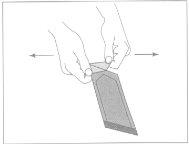
Фігура1:Для відкриття зовнішнього пакету,
знайти зігнуту частину та потягнути її назовні.
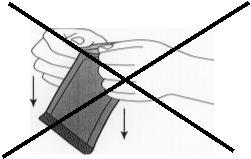
Фігура 2:Не тягнути вниз, обертаючи зап'ястья
у пакеті. Це може викликати тиск на імплантат
і пошкодити його.
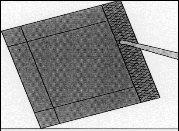
Фігура 3:Видалити внутрішній пакет за допомогою
пінцета та потягнути його вгору.
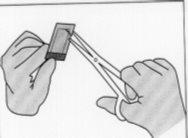
Фігура 4:Для відкриття внутрішнього пакету, тримати його
акуратно та розрізати навколо імплантату.
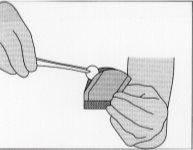
Фігура 5:Для видалення імплантату, взяти його
акуратно за допомогою пінцета та розмістити у порожнині після резекції.
У будь-якому випадку, якщо імплантат випадково впаде, його слід утилізувати належним чином.
Після завершення резекції пухлини, підтвердження діагнозу пухлини гістологічно та досягнення гемостазу, можна розмістити до 8 імплантатів для максимального покриття порожнини після резекції. Допускається легке перекриття між імплантатами. Можна використовувати імплантати, розрізані навпіл, але якщо вони розділені на більше двох частин, їх слід утилізувати у контейнерах для біоперилого сміття.
Можна розмістити смуги з оксикелулози над імплантатами для їх закріплення на поверхні порожнини. Після розміщення імплантатів порожнина після резекції повинна бути промита, а твердої мозкової оболони повинна бути закрита герметично.
Утилізація незастосованого лікарського засобу та всіх матеріалів, які контактували з ним, повинна здійснюватися згідно з місцевими правилами щодо біоперилого сміття.
- ВЛАСНИК ДОЗВОЛУ НА РЕАЛІЗАЦІЮ
CLINIGEN HEALTHCARE B.V.
Schiphol Boulevard 359
WTC Schiphol Airport, D Tower 11th floor
1118BJ Schiphol
Нідерланди
- НОМЕР(И) ДОЗВОЛУ НА РЕАЛІЗАЦІЮ
Reg. A.E.M.P.S. № 62.745
- ДАТА ПЕРШОЇ РЕГІСТРАЦІЇ/ПРОЛОНГАЦІЇ ДОЗВОЛУ
Дата першої реєстрації: 19/10/1999
Дата останньої пролонгації реєстрації: 10/12/2008
- ДАТА ПЕРЕГЛЯДУ ТЕКСТУ
Квітень 2021
- Країна реєстрації
- Діючі речовини
- Потрібен рецептТак
- Виробник
- Інформація є довідковою і не є медичною порадою. Перед прийомом будь-яких препаратів обов'язково проконсультуйтеся з лікарем. Oladoctor не несе відповідальності за медичні рішення, прийняті на основі цього контенту.
- Альтернативи до ГЛІАДЕЛЬ 7,7 мг ІМПЛАНТФорма випуску: РОЗЧИН ДЛЯ ІНФУЗІЙ, ЩО ВВОДИТЬСЯ ІН'ЄКЦІЙНО, 100 мгДіючі речовини: carmustineВиробник: Zentiva K.S.Потрібен рецептФорма випуску: РОЗЧИН ДЛЯ ІНФУЗІЙ, ЩО ВВОДИТЬСЯ ІН'ЄКЦІЙНО, 100 мгДіючі речовини: carmustineВиробник: Accord Healthcare S.L.U.Потрібен рецептФорма випуску: РОЗЧИН ДЛЯ ІНФУЗІЙ, ЩО ВВОДИТЬСЯ ІН'ЄКЦІЙНО, 300 мгДіючі речовини: carmustineВиробник: Accord Healthcare S.L.U.Потрібен рецепт
Аналоги ГЛІАДЕЛЬ 7,7 мг ІМПЛАНТ в інших країнах
Найкращі аналоги з тією самою діючою речовиною та терапевтичним ефектом.
Аналог ГЛІАДЕЛЬ 7,7 мг ІМПЛАНТ у Польща
Аналог ГЛІАДЕЛЬ 7,7 мг ІМПЛАНТ у Україна
Лікарі онлайн щодо ГЛІАДЕЛЬ 7,7 мг ІМПЛАНТ
Консультація щодо дозування, побічних ефектів, взаємодій, протипоказань та поновлення рецепта на ГЛІАДЕЛЬ 7,7 мг ІМПЛАНТ – за рішенням лікаря та згідно з місцевими правилами.






